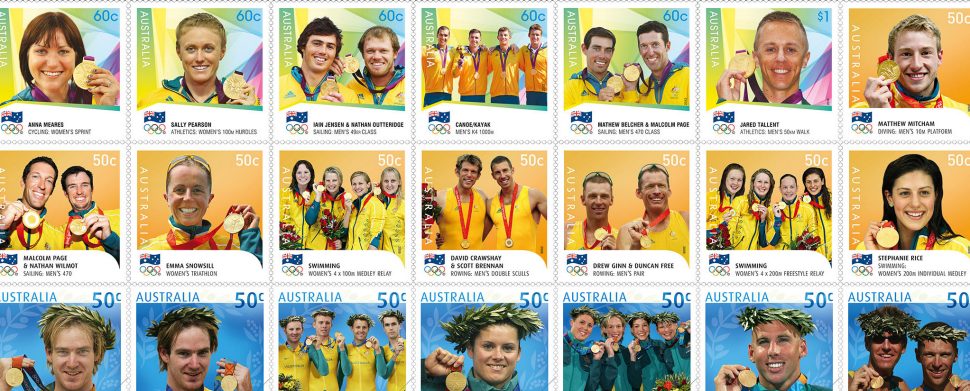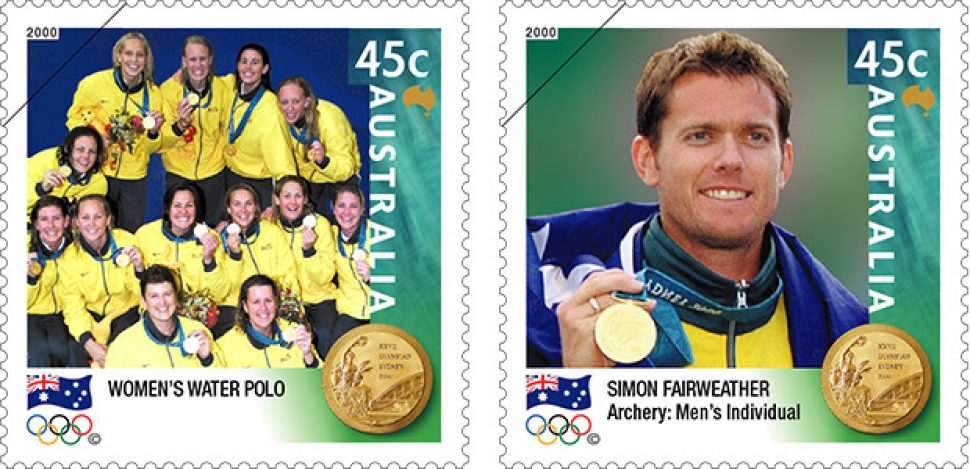In 2000, Australia Post produced instant gold medallist stamps for the Sydney 2000 Summer Olympic Games. This was not only a first for Australia, but also globally.
In a nutshell, photographs of the Australian Gold Medallists, taken during the medal presentation ceremony, were sent electronically to the design team and researchers for placement and captioning within a pre-designed and pre-approved template. Finalised designs were then sent electronically to printing staff in each capital city. The designs were digitally printed on specially produced pre-perforated paper to produce sheetlets of 10 stamps. The stamps were available to the public at 67 Post Offices around the country by noon the next day. This was an incredible feat in logistics and production as well as a departure from standard stamp printing processes.
Further supplies of the stamps, also in sheetlets of 10, were printed using offset lithography and made available within days of the medal ceremony. This is the format that continues to this day, despite the Summer Olympic Games usually occurring far from Australia, adding to the logistical efforts required!
Rio 2016 Australian Gold Medallist sheetlets
For each Australian gold medal performance at the Rio 2016 Olympic Games to date, Australia Post has produced a stamp in a sheetlet of 10. The stamp designs feature the athletes at their medal presentation ceremonies and have been made available for purchase within days of each presentation ceremony.
The 2016 Australian Gold Medallists Collection will comprise a sheetlet of 10 stamps for every Australian gold medal win during Rio 2016. This impressive keepsake will be on sale around the middle of September.
Where it all began …
In the lead-up to Sydney 2000, the Australia Post Philatelic group set an ambitious goal: to print the world’s first instant stamp for the Sydney 2000 Olympic Games. The intention was to capture the excitement and enthusiasm of each medal win in an immediate and unique way. The project was led by the then manager of Philatelic, David Maiden.
Other developments in philately were also afoot at this time. In 1999, Australia Post produced the world’s first personalised stamps. These were produced for the Australia 99 World Stamp Expo, held in Melbourne, and in many respects Gold Medallist Stamps grow out of this concept. This was also a time when the stamp issue policy had changed to allow living people other than the monarch and royal family to be featured on stamps in their own right, in some circumstances.
Into the unknown …
The project, of course, required a departure from the usual methods of stamp production at that time, i.e. photo or offset lithography following a detailed design and approval process. Usually the final stamp artwork, taking many months to develop, goes to a film reproduction house for colour separation onto four or more separate sheets of film. A proof is produced and then stamp printing plates made. Stamps are then perforated, guillotined, inspected, counted and packed.
So something radically different was required, in order to produce and distribute stamps in 24 hours! Instead of conducting the colour separation process on film, this would be completed electronically. Distribution of stamp files would be electronic and printing would be digital, directly onto pre-perforated paper, by Fuji Xerox printers.
Even with a printing process determined, there were many unknowns: This printing process had not been used before in stamp production. Would the digital technology be up for the task? Would the internet connection work, to allow for transfer of photographs and stamp files? How many gold medals would Australia win and would the Philatelic team cope with the demand?
A triumph of planning and team work
Janet Boschen was the Design Studio manager with Australia Post Philatelic when the instant stamps were developed. As Design Studio manager, Janet’s role was to oversee design, workflow and technical requirements, as well as security and transfer of digital files.
A design template was produced, which allowed space for both individuals and teams. This was pre-approved by the Australian Olympic Committee (AOC), the International Olympic Committee (IOC) and the Sydney Organising Committee for the Olympic Games (SOCOG). Specifications were developed, to ensure uniformity in layout of names and wording of events. The Philatelic researchers also needed to check and proof each stamp, before sending to the printing teams across the country.
“One of the most critical steps of the process was digital printing and stamp distribution,” says Janet.
“Only with digital printing could we deliver by midday the next day. My role extended to project management of the front end of the process – developing the technical requirements and briefing Australia Post and Fuji Xerox staff in each on how to receive design files and digitally print. It was quicker to send the stamp artwork file to each capital city, print and deliver than have all the stamps printed in Melbourne and transport stamps around the country by plane or truck!
“We did several trial runs of the process, prior to the ‘real thing’. This involved coordinating and training the Philatelic teams as well as the external teams in charge of printing and photography.”
Anticipating challenges
Janet notes that the main challenges in the instant stamps project were technological.
“Sixteen years ago, computer technology was in its infancy in Australia and we were certainly not able to send images via mobile phone. In 2000, artwork from the Philatelic Design Studio was provided to the printer on disk – CDs, as DVDs were just becoming available. The Design Studio hadn’t sent artwork electronically before.”
Janet notes that another challenge was keeping the technical workflow running, particularly as the design and front end of the process relied heavily on digital data transfer.
“Our data transfer to print was via an internal intranet, with the internet transfers as a back-up. Sending images and designs in and out of Homebush Olympic Stadium was only via the internet. All aspects of this process were covered by a digital contingency plan, except the transfer of one crucial element: the photographs from the Getty Images photographer at the stadium. If the internet connection had broken, the whole process would have come to a screaming halt! It was unknown how busy internet traffic would be, and the effect on connection and buffering speeds on the night of each medal win.
“We had a motor-bike courier at the ready, to drive 20 minutes from Homebush with the gold medallist podium images to the team of Australia Post graphic designers, who were set up in a makeshift studio in Mascot, Sydney. Thankfully, during the 16 days of the Games, the technology worked and no contingencies were required!”
Working around the clock
Another hurdle was how to monitor the Games for potential gold medal opportunities. Janet recalls:
“The Philatelic researchers had to track potential win predictions by watching TV and following newspaper schedules, as the AOC didn’t have progressive schedules on a website, as they do today. There was no SMS alert of a medal win. It was literally about tracking each potential win by watching the heats and semi-finals to see if a particular Australian athlete was in the ‘running‘ for a final.”
An exciting time
A particular highlight for Janet Boschen was the opportunity to design the Opening Ceremony stamp featuring Cathy Freeman.
“The moment when Cathy Freeman lit the Olympic Flame in the Olympic Stadium was a memorable moment and powerful image in Australian history. That stamp was voted the most popular in the 2000 Australia Post Stamp Poll, which was particularly pleasing.”
“On about day four of the Games, the then manager of Philatelic David Maiden came in with the news that customers were lining up at the Sydney GPO before the midday sale, waiting to purchase the stamps we produced that night. What a fabulous public response!” says Janet.
Designer Jo Muré agrees. Jo was one of the design team, who, along with Janet and seven other designers, lived in Sydney during the Games in order to complete the project. The Sydney 2000 Gold Medals were won late evening or into the night. That meant the Philatelic team and printing teams around the country worked at all hours to produce the stamps.
Jo recalls:
“We trained like athletes to produce the first instant stamps. We had many practice runs in the studio in Melbourne and some in Sydney. There were four or five designers working at any one time. We watched the events live in anticipation of an Australian athlete winning a Gold Medal. As soon as we knew an Australian had won we searched for the best photo. Contracted photographers had been briefed to take photos of the medals being presented to the athletes. The images usually needed work; colour corrections were made and hands were moved closer to faces to fit within the stamp space. Eyes and teeth were brightened, hair and skin was smoothed, and much more. The athlete’s image, names and events were provided and checked by the researcher. The completed stamp was then sent to the AOC to be approved. This approval could take up to several hours. Once we had approval, files were set up and sent to be printed.”
But it wasn’t all work and no play. Jo recalls being able to see some of Sydney and the Games themselves:
“It was an extremely exciting time to be in Sydney. The streets were decorated with Olympic signage everywhere. There were bands and giant TV screens in all the key places. People from all over the world gathered to watch the athletes compete. Australians were very supportive and excited by it all. You could hear people cheering and screaming when the events were aired. The atmosphere was electric. The instant stamp team watched nervously as the Australians competed. When we won we went into work mode; we had a deadline and a job to get done!”
“A lot of the work was done late at night, through to early morning, so the day was usually free to explore Sydney. We were always on call though, so we couldn’t go too far. I was lucky to watch the Australian volleyball event on the beach. There was a stadium built on the sand, it was always crowded with excited fans. The loud music and cheering created a fantastic atmosphere. After the Sydney games I was lucky enough to meet the two women’s volleyball gold medallists at an Australia Post celebration event.”
A spectacular result
The gold medal instant stamp sheetlets of Sydney 2000 proved incredibly popular, both with collectors and the general public. If the inaugural gold medal instant stamp project wasn’t impressive enough, it’s testament to the dedication of the Philatelic team that they have managed to continue the project, despite significant time differences in the Games that have followed Sydney 2000.
The 2016 Australian Gold Medallist sheetlets are available online, at participating Post Offices and via mail order on 1800 331 794, while stocks last.
The 2016 Australian Gold Medallists Collection will be on sale from around the middle of September, at participating Post Offices, online, and via mail order on 1800 331 794, while stocks last.
This article was produced at the time of publication and will not be updated.




